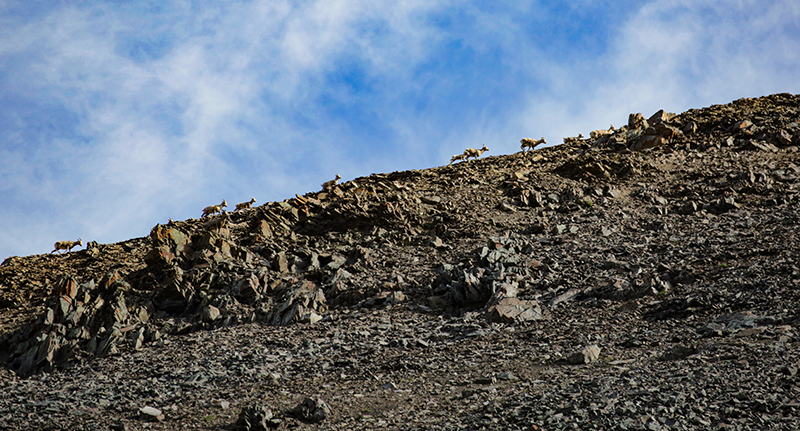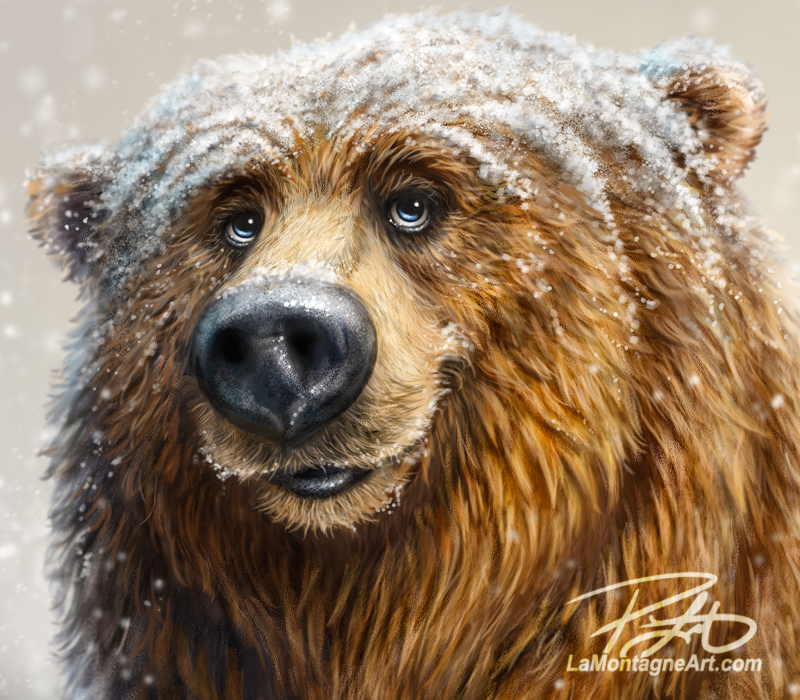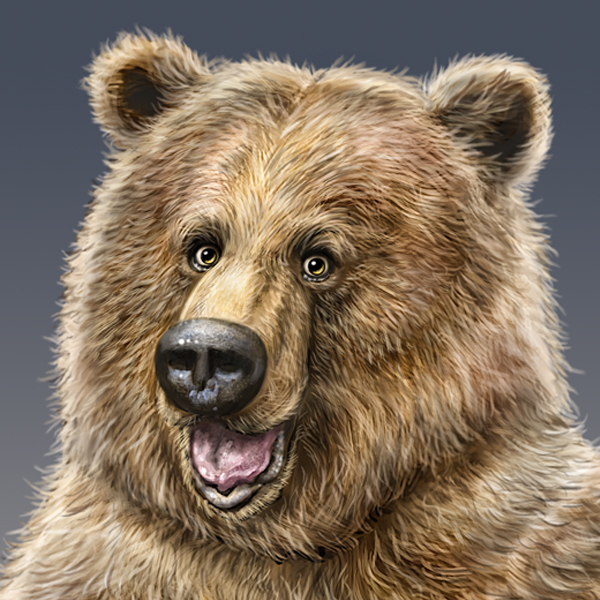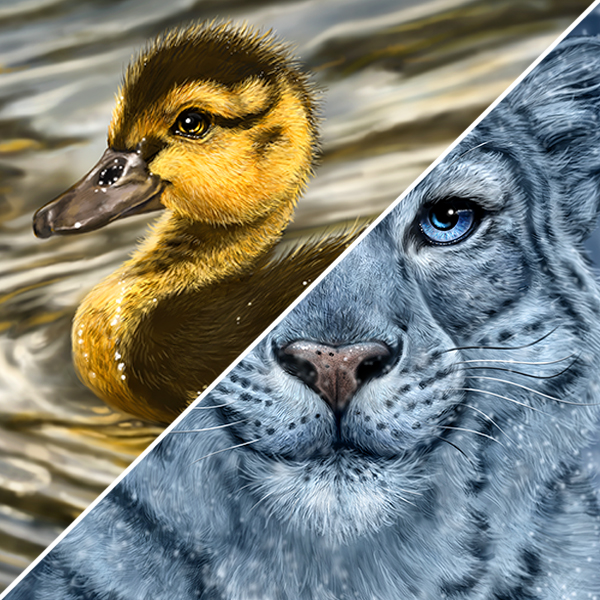
As the colder weather approaches, animal photo opportunities become less plentiful, and that scarcity, real or imagined, makes me want to take more pictures.
Considering I have thousands of neatly organized reference photos I have never used, for well over a hundred animals, running out has never been a problem. But it’s hard to ignore the impulse to stock up, just in case.
Hey, squirrels store way more than they need for the winter, too.
Time ticking was the prime motivation for my trip to the Alberta Birds of Prey Sanctuary in Coaldale last month. Releasing two hawks into the wild was worth the trip alone, but after editing and sorting my pictures, I’ve also got dozens of new photos I can paint from.
Still open until September 30th, Discovery Wildlife Park usually closes from October to the end of April. But during the pandemic, they created a holiday lights drive-through feature. With the worst of the health crisis thankfully over, their impressive Light The Night experience has continued to grow, open this year from November 15th to January 5th.
With winter gift shop stock in mind, they placed a surprising end-of-season order for prints and stickers. I always like to deliver those in person so I have an excuse to take photos.
I had driven to Coaldale in a torrential rainstorm, but that meant great light for pictures when I arrived. In an unwelcome repeat, but with the same result, I drove to Innisfail last week in another storm. When I got there, the weather was so foul I was the only person in the park.
 While I had lunch with my zookeeper friend, Serena, a couple of other people arrived. Coincidentally, they were also longtime friends of the park. Rather than the usual bear education presentation we’d seen several times, Serena gave the three of us a behind-the-scenes personal tour and visit with the bears.
While I had lunch with my zookeeper friend, Serena, a couple of other people arrived. Coincidentally, they were also longtime friends of the park. Rather than the usual bear education presentation we’d seen several times, Serena gave the three of us a behind-the-scenes personal tour and visit with the bears.
 Cold, dark, and windy, the rain at least let up for a few hours. While the pictures I got weren’t impressive photographs on their own, some of these shots will be amazing for reference. I’ve written before about how sunny days aren’t great because they can wash out detail in the highlights and shadows, but an overcast day provided some very exciting photos of bear fur and features.
Cold, dark, and windy, the rain at least let up for a few hours. While the pictures I got weren’t impressive photographs on their own, some of these shots will be amazing for reference. I’ve written before about how sunny days aren’t great because they can wash out detail in the highlights and shadows, but an overcast day provided some very exciting photos of bear fur and features.
 If that weren’t enough, Serena has been hand-raising an orphaned raccoon since he was tiny. Shonna I got to see him earlier this summer, but on this day, he was getting his first look at a much bigger world, as he was let loose for a bit to run and play in a large enclosure. If you’ve ever seen a cat or dog with the zoomies, imagine that with a raccoon. He was having a very good time.
If that weren’t enough, Serena has been hand-raising an orphaned raccoon since he was tiny. Shonna I got to see him earlier this summer, but on this day, he was getting his first look at a much bigger world, as he was let loose for a bit to run and play in a large enclosure. If you’ve ever seen a cat or dog with the zoomies, imagine that with a raccoon. He was having a very good time.
 After the park, I took my parents out to dinner in Red Deer and spent the night at their place for a nice, albeit short, visit.
After the park, I took my parents out to dinner in Red Deer and spent the night at their place for a nice, albeit short, visit.
This past week, the cool fall weather has shown up. Though I’m not a fan of the winter that follows, fall is my favourite time of year. The light on the mountains around here is softer and ever-changing, and we get some beautiful sunrises, which I can see from my office window. And when the larches change colour, it’s like somebody spilled brilliant yellow and orange paint all over the place.
Though I generally dislike driving, the route south on Highway 40 through Kananaskis, up to the Highwood Pass is an exception. It’s the highest paved road in Canada and the spectacular scenery is some of the most beautiful in the world. While busy on weekends, self-employment affords me the luxury of going during the week. Thursday was a pretty day for a drive, and even though the larches haven’t changed yet, they’re beginning to. Traffic was light, the weather was great, and I enjoyed the 40-minute climb from Highway 1.
 Several years ago, a local photographer told me about Rock Glacier, just off the highway below the Highwood Pass. He had said that if I wanted to see pikas, that was the place. It’s a massive scree slope of rocks, and I can’t even guess how many of the little ‘rock rabbits’ call it home.
Several years ago, a local photographer told me about Rock Glacier, just off the highway below the Highwood Pass. He had said that if I wanted to see pikas, that was the place. It’s a massive scree slope of rocks, and I can’t even guess how many of the little ‘rock rabbits’ call it home.
It’s hardly a secret, as the site has two extra parking lanes and several Alberta Parks educational signs about the critters.
Their peeping is unmistakable, but it can be hard to see them as they’re very small and perfectly camouflaged among the rocks. It’s only their darting movements that give them away. I’ll admit that chasing them around the rocks is part of the fun. They’ll scurry along routes only they can see, pausing on rocks along their path, perfect for photo ops.
 Their primary motivation is food, so they’re usually en route to one of the small patches of grass and vegetation among the rocks, where they’ll stuff their faces before running back to their stash. It’s fun to watch.
Their primary motivation is food, so they’re usually en route to one of the small patches of grass and vegetation among the rocks, where they’ll stuff their faces before running back to their stash. It’s fun to watch.
The challenge is usually to get a few pictures before they run out of range, but twice on this visit, I was delighted to see one running toward me. With each pause, I’d get a better shot until one eventually ran right by my foot, intent on a patch of green behind me. All I had to do was circle it and take more photos. They didn’t seem to mind my presence as long as I avoided quick movements.
 It can get cold up there at 2200m (7200 ft), and I always pack extra layers, but it was a pleasant fall morning, and I only needed a light jacket. On a few visits, there’ve been ten or 12 other people, often photographers with much bigger lenses than my 70-300mm, doing the same thing. But on this visit, I spent an hour and a half crawling over the rocks and snapping pics with the whole place to myself. Nobody else stopped.
It can get cold up there at 2200m (7200 ft), and I always pack extra layers, but it was a pleasant fall morning, and I only needed a light jacket. On a few visits, there’ve been ten or 12 other people, often photographers with much bigger lenses than my 70-300mm, doing the same thing. But on this visit, I spent an hour and a half crawling over the rocks and snapping pics with the whole place to myself. Nobody else stopped.
 On each drive up to Rock Glacier, I usually see black bears or grizzlies, but none this time. They’re likely still low in the valleys, eating as much as possible before winter. But they can show up anywhere around here, and on these excursions, I’ve always got bear spray on my hip. Aside from the above pic of a line of bighorn sheep walking the top of the ridge, I only saw the wildlife I came for.
On each drive up to Rock Glacier, I usually see black bears or grizzlies, but none this time. They’re likely still low in the valleys, eating as much as possible before winter. But they can show up anywhere around here, and on these excursions, I’ve always got bear spray on my hip. Aside from the above pic of a line of bighorn sheep walking the top of the ridge, I only saw the wildlife I came for.
 Though I have kept dozens of pika photos over the years, I’ve always felt I hadn’t quite got the one I wanted, that perfect photo to paint from. I finally got one on this trip, but I haven’t shared it in this post. It’ll just have to be a surprise.
Though I have kept dozens of pika photos over the years, I’ve always felt I hadn’t quite got the one I wanted, that perfect photo to paint from. I finally got one on this trip, but I haven’t shared it in this post. It’ll just have to be a surprise.
Now, you might be thinking, “I’m seeing plenty of photos lately, but where’s some new artwork on this artist’s website?”
I am working on several pieces and a commission right now. However, taking photos for future paintings is also a big part of my work. I can’t paint ‘cartoony, but real,’ if I don’t know what real looks like, and taking photos always inspires new paintings. Though I often plan to paint a critter and then go looking for reference, it’s frequently the photos that come first, inspiring the paintings that follow.



 This painting has been rattling around in my noggin for some time. I think I first had the idea at the Calgary Zoo when I saw Skoki, the grizzly bear, sitting in one of his ponds, playing with something floating on the water.
This painting has been rattling around in my noggin for some time. I think I first had the idea at the Calgary Zoo when I saw Skoki, the grizzly bear, sitting in one of his ponds, playing with something floating on the water. Eventually, it comes together, the personality shows up, and it turns into an enjoyable pursuit rather than a frustrating one. What was at first a slog, seeming like hours of no progress, ended up to be work I didn’t want to stop.
Eventually, it comes together, the personality shows up, and it turns into an enjoyable pursuit rather than a frustrating one. What was at first a slog, seeming like hours of no progress, ended up to be work I didn’t want to stop.

 Earlier this year, I surveyed subscribers to
Earlier this year, I surveyed subscribers to 
 I’ll have another fully rendered new painting to share with you soon, but while you wait, here’s another recent piece I drew for the bear book.
I’ll have another fully rendered new painting to share with you soon, but while you wait, here’s another recent piece I drew for the bear book.


 In 2008, I hosted the Canadian Editorial Cartoonists Conference in Banff. Several industry veterans who attended came up in a culture where busy unionized daily newspapers hired editorial cartoonists for impressive salaries, benefits, and pensions. I began my career at the end of all that.
In 2008, I hosted the Canadian Editorial Cartoonists Conference in Banff. Several industry veterans who attended came up in a culture where busy unionized daily newspapers hired editorial cartoonists for impressive salaries, benefits, and pensions. I began my career at the end of all that.
 Eventually, social media killed the forum, and the organization rebranded. As a result, NAPP no longer exists, and the Photoshop World conference is a ghost of its former self.
Eventually, social media killed the forum, and the organization rebranded. As a result, NAPP no longer exists, and the Photoshop World conference is a ghost of its former self. I’ve taken a new approach with the trio of giraffes, already titled “Long Neck Buds.” I don’t know if it will work the way I imagine it, but if it does, it will be the first of several I plan to paint this way.
I’ve taken a new approach with the trio of giraffes, already titled “Long Neck Buds.” I don’t know if it will work the way I imagine it, but if it does, it will be the first of several I plan to paint this way. I’m a commercial artist, it’s how I make my living. I don’t pretend otherwise. But this is also supposed to be fun. I want to paint more detailed and elaborate images I’ll enjoy while also leaving options open for clients and licenses with different needs.
I’m a commercial artist, it’s how I make my living. I don’t pretend otherwise. But this is also supposed to be fun. I want to paint more detailed and elaborate images I’ll enjoy while also leaving options open for clients and licenses with different needs.






















